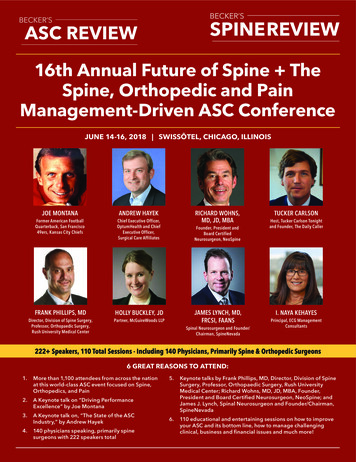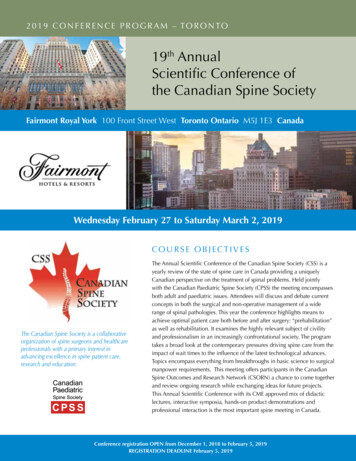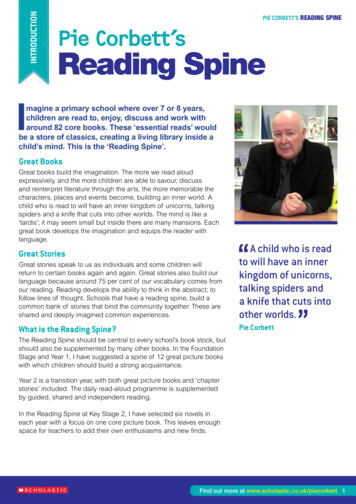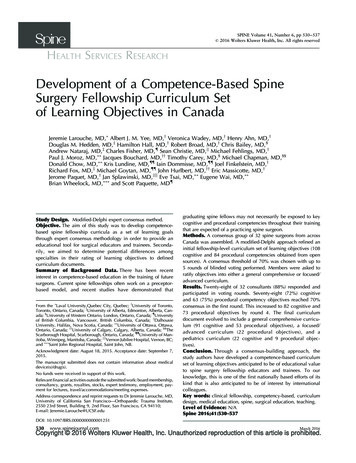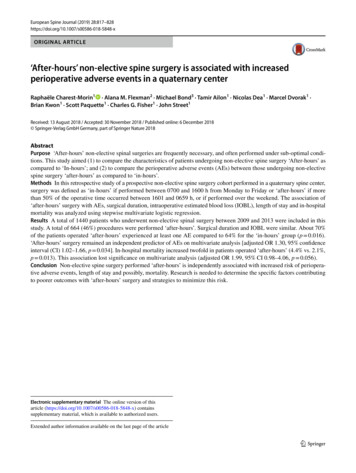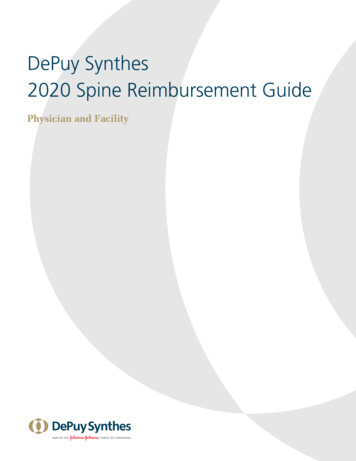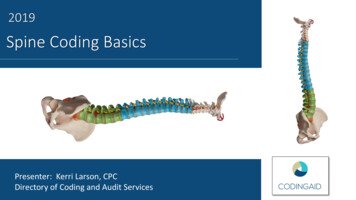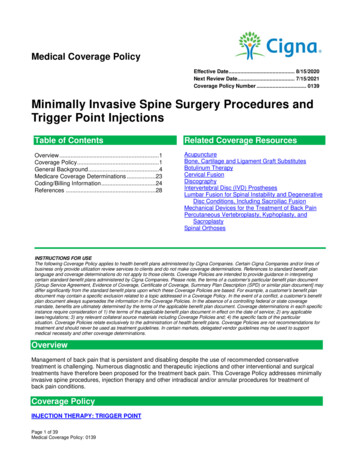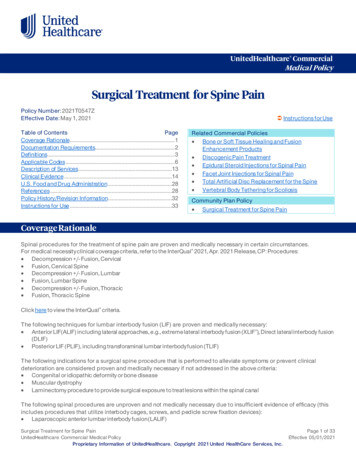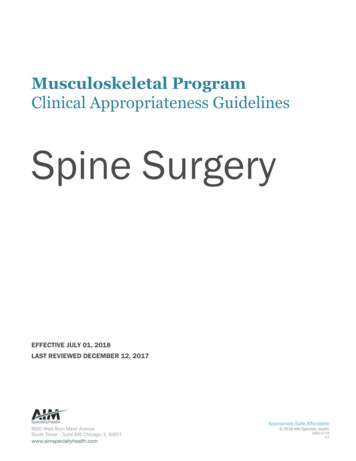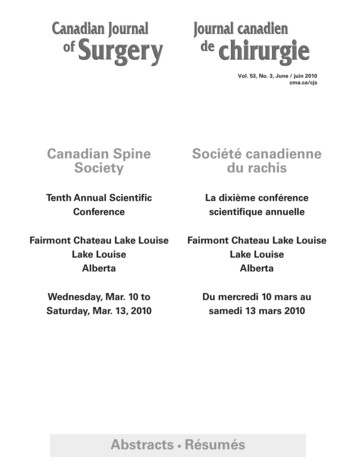
Transcription
Vol. 53, No. 3, June / juin 2010cma.ca/cjsCanadian SpineSocietySociété canadiennedu rachisTenth Annual ScientificConferenceLa dixième conférencescientifique annuelleFairmont Chateau Lake LouiseLake LouiseAlbertaFairmont Chateau Lake LouiseLake LouiseAlbertaWednesday, Mar. 10 toSaturday, Mar. 13, 2010Du mercredi 10 mars ausamedi 13 mars 2010Abstracts Résumés
SOCIÉTÉ CANADIENNE DU RACHISCanadian Spine Society abstractsPodium presentationsThe reliability of differentiating neurogenic claudicationfrom vascular claudication based on symptomatic presentation. Melissa Nadeau,*† Patricia Rosas Arellano,*Kevin Gurr,*† Stewart Bailey,*† Brian Taylor,*† Ruby Grewal,*†Kirk Lawlor,*† Chris Bailey.*† From the *London HealthSciences Centre, and the †University of London Ontario,London, Ont.Introduction: Claudication is a common complaint of elderlypatients. Lumbar spinal stenosis (LSS) and peripheral arterial disease (PAD) are the 2 main etiologies, producing neurogenic andvascular claudication, respectively. Physicians initially diagnoseclaudication based on a “typical” symptom profile. The reliabilityof this symptom profile to accurately diagnose LSS or PAD as acause of claudication is unknown, leading to the potentiallyunnecessary use of expensive and overly sensitive imaging modalities. Furthermore, clinicians rely on this symptom profile whendirecting treatment for patients with concurrent imaging positivefor LSS and PAD. This study evaluates the reliability of varioussymptom attributes, which classically have been used to characterize and differentiate the two. Methods: Patients presenting ata tertiary care centre’s vascular or spine clinics with a primarycomplaint of claudication were enrolled in the study. A diagnosisof either LSS or PAD was confirmed by imaging for each patient.Patients answered 14 questions characterizing their symptoms.Sensitivity, specificity, positive and negative likelihood ratios(PLR, NLR) were determined for each symptom attribute.Results: The most sensitive symptom attribute to rule out LSSwas “triggering of pain with standing alone” (0.96). Four symptom attributes demonstrated a high PLR and 3 had low a NLRfor diagnosing neurogenic claudication (PLR 3.08, 2.51, 2.14,2.9; NLR 0.06, 0.29, 0.15). In vascular patients, calf symptomsand alleviation of pain with simply standing had a high PLR andNLR (PLR 3.08 and 4.85; NLR 0.31 and 0.36). Conclusion:Only 4 of 14 “classic” symptom attributes were highly sensitivefor ruling out LSS and should be considered by primary carephysicians before pursing expensive diagnostic imaging. Sixsymptom attributes should be relied upon to differentiatebetween LSS and NLR. Numbness, pain triggered with standingalone, location in the buttock and thigh and relief following sitting are symptom attributes that reliably characterize neurogenicclaudication.Orthopedic and neurosurgical spine fellowship training:an evaluation of cognitive and technical competencies.Harsha Malempati,* Scott Paquette,† Eric Massicotte,‡Veronica Wadey,*§ Hans Kreder,*¶ David Backstein,* **Albert Yee.*¶ From the *Division of Orthopaedic Surgery,University of Toronto, Toronto, Ont., the †CombinedNeurosurgical and Orthopaedic Spine Program, Vancouver General Hospital, University of British Columbia,Vancouver, BC, the ‡Department of Neurosurgery, University of Toronto, and the University Health Network,S26J can chir, Vol. 53, Suppl., juin 2010 — RésumésToronto Western Hospital, the §Holland Orthopaedic andArthritic Institute, the ¶Sunnybrook Health SciencesCentre, and **Mt. Sinai Hospital, Toronto, Ont.Objective: To evaluate fellowship trainee and supervisor perceptions of the relative importance of cognitive and procedural competencies in spine fellowship training. Methods: A questionnairewas administered (online and on paper) to fellow trainees andsupervisors across Canada, and data were collected over a 3month period. The questionnaire consisted of 40 multiple choiceitems grouped into 13 broad cognitive skills categories, as well as29 technical/procedural items. This questionnaire was reviewedfor content by spinal surgery experts (Canadian Spine SocietyEducation Committee). Data were analyzed using qualitative anddescriptive statistics (e.g., average mean scores, standard deviations, t tests). Results: The response rate was 91%, with 15 of 17fellow trainees and 47 of 51 supervisors completing the survey.Twelve of the 13 cognitive skill categories were rated as beingimportant to acquire by the end of the fellowship. Trainees werenot comfortable performing and requested additional training in8 of 29 spine surgery technical skill items. Specifically, additionaltraining was believed to be required for intradural procedures(e.g., syringomyelia, intradural neoplasms) and other less common, technically demanding procedures (e.g., transoral odontoidectomy, anterior thoracic discectomy). Significant differences(p 0.05) existed in the perceptions of the importance of specificcognitive and technical skills based on previous residency training(orthopedic or neurosurgical). No such differences were foundwhen comparing the responses of fellow trainees and their supervisors. Conclusion: This study demonstrates that fellowshiptrainees and supervisors have similar perceptions about the relative importance of specific cognitive and procedural competenciesrequired to successfully complete spine fellowship training. Furthermore, background specialty training (orthopedic or neurosurgical) influences the perceptions of both fellow trainees andsupervisors regarding the importance of cognitive and technicalskills deemed necessary for successful training.Surgeon–industry conflict of interest: survey of NorthAmericans’ opinions regarding industry-sponsorededucational events and surgeon teaching.Christian DiPaola, * Charles Fisher, † Hongbin Zhang, †Vanessa Noonan, † Marcel Dvorak. † From the *SpineDivision, Department of Orthopaedics, University ofMassachusetts Medical Center, Worcester, Mass., andthe †Combined Neurosurgery and Orthopaedic SpineProgram, University of British Columbia, Vancouver, BCIntroduction: Surgeons are often reimbursed as faculty for continuing medical education (CME) events. Industry often sponsorsprofessional society meetings such as the American Academy ofOrthopaedic Surgeons and other CME events. The nature andextent of surgeon–industry conflict of interest (COI) has become 2010 Association médicale canadienne
CANADIAN SPINE SOCIETYa source of considerable interest. Doctors, companies and government leaders have attempted to regulate potential COIs without the opinion of the general public. The objectives of thisstudy were to assess the opinions of North Americans on COIissues regarding CME events and to analyze population subgroups that may form similar opinions. Methods: A web-basedsurvey was administered to sample opinions on reimbursement,disclosure and funding sources for educational events. The validity of hypothetically similar questions was calculated, and subgroup analysis was performed for respondent age, sex, education,insurance and patient status. Results: In all, 501 of 542 surveyshad complete data. Our sample population was composed ofmore females and was older and more educated than a representative cross section of the American population. There was ahigh validity content for questions. Most opinions did not differamong subgroups unless weighted to represent the Americanpopulation census data. Over 90% of respondents felt that industry funding for surgeon tuition and travel for either industrysponsored or professional society CME meetings would notaffect their quality of care. Respondents were also generally infavour of educational conferences for surgeons regardless offunding type. Dislcosure of surgeon–industry relations appearedto be important to respondents. Conclusion: The developmentof evidence-based treatment recommendations requires theinclusion of patient choice and opinion as central components ofthe process. The vast majority of respondents in our study donot feel that the quality of their care would diminish because ofindustry funding of educational events, surgeon tuition and/ortravel expenses.Management of stable thoracolumbar burst fractures:a randomized trial of bracing versus no bracing.Eugene Wai, Mohammed Shamji, Daryl Young,Garth Johnson, Joe O’Neil, R. Reindl. From The OttawaHospital, Ottawa, Ont.Objective: The management of thoracolumbar burst fracturesdepends on the clinical presentation of neurologic deficit andradiographic features of fracture severity suggestive of instability.When patients are neurologically intact and have mild deformityon computed tomography, conservative therapy may be used; thistypically involves bracing over months to permit fracture stabilization. We investigated the utility of bracing versus no bracingamong stable thoracolumbar burst fractures. Methods: Patientswith stable thoracolumbar burst fractures, single-level betweenT12 and L2, with no neurologic deficit or lower extremity injurywere entered into this study. Randomization was computer generated in sealed envelopes. We examined patient data on presentation and at 6 months follow-up, including radiographic outcomes of kyphosis and loss of anterior vertebral height andclinical self-reported pain and disability outcomes. Continuousvariables were analyzed by 2-factor analysis of variance (time,treatment) at the 0.05 level of significance. Results: Seventeenpatients were randomized: 9 were treated with bracing and 8without bracing. There were no differences between patientstreated with or without bracing regarding the level of injury (p 0.18) and initial spine geometry, including the extent of fragmentretropulsion (p 0.97), anterior loss of height (p 0.56) or Cobbangle (p 0.26). Progressive loss of height occurred an additionalmean 17% (SD 4%) in both groups (p 0.96). The degree of 2010 Canadian Medical Associationkyphotic progression was also no different by treatment (bracing:mean 6 [SD 2 ], no bracing: 8 [SD 2 ]; p 0.59). Improvementsin self-reported pain and disability were observed in both treatment groups, to a similar extent regardless of treatment (p 0.40).Conclusion: Patients with stable thoracolumbar burst fracturestreated with or without bracing had similar outcomes at6 months. Radiographic outcomes of fracture geometry and clinical outcomes of pain and disability scores were no different bytreatment type. These patients may benefit from conservativetherapy simply involving sequential imaging without brace immobilization, although a larger patient series is required.Early surgical intervention for spinal cord injury:acute phase evaluation of the Ontario experience.Anoushka Singh, * Tara Kamali-Nejad, * Mingyang Li, *Michael Fehlings.*† From the *Toronto Western Hospitaland the †University of Toronto, Toronto, Ont.Background: There is much debate and uncertainty aboutwhich patients with a spinal cord injury (SCI) would benefit fromsurgical decompression and the optimal timing for such surgery.We sought to evaluate the rates of surgery and the relationbetween the timing of decompressive surgery and early outcomes(neurologic status and length of stay) in a prospective cohort ofpatients. Methods: Patients with an SCI categorized as American Spinal Injury Association (ASIA) level A–D and radiologicalevidence of cord compression were entered into this multicentrestudy at 6 spine centres in Ontario. Patients were stratified into“early” ( 24 h) or “delayed” ( 24 h) groups based on the time todecompression. The ASIA neurologic outcome scores (at baselineadmission, after surgery and at discharge from the acute carefacility) and length of stay were evaluated. Results: To date,118 patients (mean age 44.4 [SD 17.27] yr; 79.66% male :20.34% female) have been enrolled in the study, and 104 (88%)have undergone surgery. Surgery resulted in improvement ofASIA scores across patients with different levels of spinal cordimpairment. The early group was younger (mean 41.22 [SD16.31] yr) than the late group (mean 45.90 [SD 17.14] yr). Atacute discharge, 22.58% patients in the early group had a gradeimprovement of 1 or greater in their ASIA score compared with15.69% in the delayed group (p 0.1680). Of patients with aninjury scored ASIA-A and early surgery, 22.22% had a gradeimprovement of 1 or greater from admission to acute discharge inthe ASIA score compared with 6.25% in the delayed group (p 0.1760). Length of stay was significantly shorter in the early(mean 16.17 [SD 12.25] d) versus the delayed (mean 24.82 [SD22.82] d) or no surgery group (mean 26.31 [SD 47.37] d) (p 0.05). Conclusion: Surgical intervention is common in SCIpatients, and it is associated with reduced length of stay. Initialresults of this study of a prospective Canadian cohort of patientsin the Ontario Spinal Cord Injury Registry suggest that early surgical intervention in SCI may be associated with improved neurologic recovery. These data will require validation in a large cohortwith longer-term follow-up.Cervical spine fractures with spinal cord injuries in theelderly: factors affecting mortality. Parham Daneshvar,*Yasser Brikeet,† Chris Bailey,† Eugene Wai.* From *TheOttawa Hospital, Ottawa, and the †London Health SciencesCentre, London, Ont.Can J Surg, Vol. 53, Suppl., June 2010 — AbstractsS27
SOCIÉTÉ CANADIENNE DU RACHISPurpose: Cervical spine fractures in the elderly carry a high rateof mortality. The purpose of this study was to determine whatfactors affect the mortality rate in this patient population.Methods: We identified, 37 patients aged 60 and older (averageage 75 yr) who had cervical spine (C-spine) fractures with spinalcord injuries and who were followed at two level 1 trauma centresin Ontario. Data were collected prospectively and analyzedregarding patient level and degree of injury, preinjury comorbidities, treatment and cause of death. The results were subjected tostatistical analysis to identify factors affecting mortality. Results:There was a mortality rate of 38% in this population. The number one cause of death was respiratory failure. Previous comorbidities and age did not seem to affect mortality. The mortalityrate of patients with complete cord injuries was 2.6 times higherthan those with incomplete cord injuries (p 0.022). Patients witha score of A or B on the American Spinal Injury Associationimpairment scale were 2.1 times more likely to die of theirinjuries than those with a score of C or D. Previous history ofspinal stenosis seemed to protect patients from having a completecord injury, and patients with a dislocation were 3 times morelikely to have a complete cord injury (p 0.04), compared withpatients with fractures and no dislocation. Operative versus inoperative treatment did not affect mortality in this series of patients.In addition, neurologic recovery appeared to be uncommon inthis age population. Conclusion: Having a complete cord injurysignificantly increases mortality in the elderly population withC-spine fractures. In addition, the degree of cord injury hasconsiderable effect on outcome, and the level of injury may play arole in mortality. Although each case of C-spine injury is different,this study should guide physicians and patients in assessing prognosis after such injuries.Balloon kyphoplasty improves both Roland Morris Disability Questionnaire scores and bone pain among cancer patients with vertebral compression fractures:interim analysis of results from a phase IV randomizedtrial. Peter Jarzem, James Berenson, John Tillman,Mohamed Hussein, Robert Plugmacher, Sami Elmoufti,Frank Vrionis. From McGill University, Montréal, Que.Purpose: Destructive vertebral lesions are a common source ofmorbidity among patients with cancer. We report the results ofthe first multisite randomized trial among 134 cancer patientswith vertebral compression fractures (VCFs) to assess the efficacyand safety of this procedure. Methods: Adult patients diagnosedwith a variety of cancers and fewer than 3 painful VCFs (4 on avisual analogue scale [VAS] for pain) were randomly assigned toimmediate kyphoplasty (n 70) or nonsurgical supportive care(n 64). Results: The primary outcome measures were the RolandMorris Disability Questionnaire (RMDQ) and VAS back painscores. Single VCFs were identified in 43% of patients, and 29%of patients had 2 or 3 fractures. We evaluated 59 kyphoplasty and56 nonsurgical patients in the efficacy analysis. Baseline RMDQscores improved by 8.3 points in the kyphoplasty group and didnot change in the control group (p 0.01). Pain scores showed asimilar change, with the kyphoplasty group improving by 3.6 (p 0.01) and the control group not improving at 1 week (p 0.01).At 1 month, patients who underwent kyphoplasty had on averagea –4.1 improvement in pain, and those treated nonsurgically hadno improvement (p 0.0001). There was no significant differenceS28J can chir, Vol. 53, Suppl., juin 2010 — Résumésin the number of patients with serious adverse events between thekyphoplasty (16) and nonsurgical (10) groups at 1 month. Noneof the serious adverse events in the kyphoplasty group wererelated to the devices used. There was a non–Q wave myocardialinfarction that resolved in the kyphoplasty group. Conclusion:Our planned interim analyses of results from this ongoing randomized study show that patients with cancer-related VCFstreated with immediate balloon kyphoplasty show a markedreduction in back disability and pain at 1 month compared withnonsurgical treatment. Since the minimally clinical significantchanges in the RMD and pain scales are 2.5 and 2.0 points,kyphoplasty in patients with cancer achieved both statistically andclinically significant improvements over control patients withoutan increase in adverse events.Morbidity and mortality in major adult spinal surgery: aprospective cohort analysis of 942 consecutive patients.John Street, * Brian Lenehan, * Michael Boyd, *Marcel Dvorak, * Brian Kwon, * Scott Paquette, *Raja Rampersaud,† Charles Fisher.* From the *CombinedNeurosurgical and Orthopaedic Spine Program, Vancouver, BC, and the †Spine Program, Toronto, Ont.Purpose: Our aims were, first, to determine the incidence ofmorbidity (major and minor, medical and surgical) and mortalityin adults undergoing complex spinal surgery, both trauma andelective, in a quaternary referral centre, and second, to examinethe influence of the introduction of a prospective perioperativemorbidity abstraction tool on the recording of these data. Methods:Data on all patients who had surgery over a 12-month periodwere prospectively collected using the perioperative morbidityabstraction tool as proposed by the Spine Trauma Study Group.Prior to the introduction of this system, and using the hospitalinpatient database, our documented perioperative morbidity ratewas 23%. Diagnosis, operative data, hospital data, major andminor complications both medical and surgical, and deaths wererecorded. Results: All patients discharged from the unit hadcomplete data available for analysis; 942 patients with an agerange of 16 to 90 years (mean 54, mode 38 yr) were identified.There were 552 male and 390 female patients; 58.5% of patientshad undergone elective surgery; 30% of patients had injuriesgraded American Spinal Injury Association (ASIA) level A orworse on admission. The average length of stay was 13.5 days(range 1–221 d). In total, 822 (87%) patients had at least 1 documented complication. There were 14 deaths during the studyperiod. The rate of intraoperative surgical complication was10.5% (4.5% incidental durotomy, 1.9% hardware malpositionrequiring revision and 2.2% blood loss 2 L). The incidence ofpostoperative complication was 73.5% (wound complications13.5%, delerium 8%, pneumonia 7%, neuropathic pain 5%, dysphagia 4.5% and neurologic deterioration 3%). Conclusion:Major spinal surgery in adults is associated with a high incidenceof intra- and post
Orthopedic and neurosurgical spine fellowship training: an evaluation of cognitive and technical competencies. Harsha Malempati,* Scott Paquette,† Eric Massicotte,‡ Veronica Wadey,*§ Hans Kreder,*¶David Backstein, * Albert Yee.*¶ From the *Division of Orthopaedic Sur
